Now You Know Latest Dry Washing Techniques in Denim Garments (Part-3)
Monday, 21 January 2019
Edit
Latest Dry Washing Techniques in Denim Garments (Part-3)
Asma Akhi
&
Md.Hasibur Rahman Sunny
Dept. of Textile Engineering
Bangladesh University of Business & Technology
&
Md.Hasibur Rahman Sunny
Dept. of Textile Engineering
Bangladesh University of Business & Technology
Previous Post
CHAPTER-03
Raw Materials & Methodology
Raw Materials & Methodology
The methodology of this project work was experimental. To perform a successfully experiment, the following materials, chemical, instrument and methods were used in our project work.
Material:
- Denim Fabric (70% Cotton 20% Poly 10% Rayon)
- Emery Paper (320)
- Potassium Permanganate(KMnO4)
- Resin
- Neutral Agent(Meta BSF)
- Desizing Agent
- Enzyme Agent
- Sodium Carbonate/Soda Ash
- Bleaching Powder
- Softener
- Paradise Washing Plant Ltd.
- Testing laboratory in Bangladesh University of Business & Technology
- Wet Processing Laboratory in Bangladesh University of Business and Technology (BUBT)
- Destroy Machine
- Pressing Crinkle Machine
- Iron Machine (For Crinkle)
- Tagging Machine
- Spray Gan Machine (For PP Spray)
- Sample Washing Machine
- Hydro-extractor
- Dryer Machine
For Hand Scraping/Hand Brush:
Material: Emery paper
Instrument: Rubber Balloon/Dummy etc.
Method:
Hand brush with paper, commonly known as scrapping is the most widely used process for creating the blasting effect. It is usually done by mounting the garment on rubber balloons. After mounting the garment air balloon is filled with air to expose the area to operate. It is important to fill the pressure.
Hand sand is the step which is generally being done in rigid form of garments to get the distressed look. Locations can be front thigh & back seat or it can be overall / global application as per the Standard. Emery paper is being used to scrape the garments in particular placement & design. Emery paper comes in different number generally start from 40 till 600 and above, higher the number finer the emery paper, lower the coarseness of the paper. In the garment industry from 220, 320 & 400 number papers are most popular & widely used. Purpose of doing this process is make used worn out look to the garments.
Most common used grade no of emery paper is 320.Then sent for further processing. Hand rubbing is done on specific area of garments by emery paper according to approve sample. One garment must be done by one operator only to have balance intensity on both the leg.
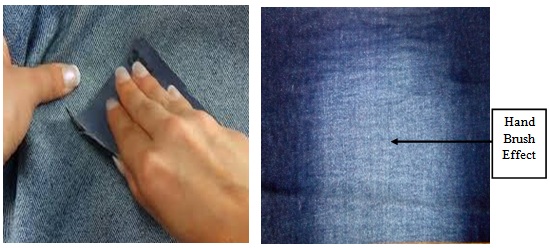 |
| Fig 03: Hand Brush Sample |
Material: Emery Paper, Stone Tools
Instrument: Destroy Machine, Hacksaw Blade, Knife, Needle etc.
Method:
Destroy is newly fashion on garments. One of the most popular distressing effects currently, ‘Destruction’ is an art which make denim look unique & used. It can also be achieved by cutting it thru knife the warp yarns & keep the weft yarn as is to show white thread. Holes also can be made by cutting weft & warp yarns. These are all manual processes & every garment will look unique & different than others.
- We can make holes in jeans by overdoing different methods. The trick is to make the holes look natural. Grind away at the fabric slowly. Try not to localize the worn area, spread it with diminishing wear the further we get from the intended hole.
- The area around the hole should be worn out as well as bleached to further blend the hole with the surrounding fabric. "Finish" the edges with a pumice stone or sandpaper dampened in bleach. Also dampening a sponge with bleach and applying it to the outer edges of the hole will add to the natural worn look.
- It is important that what types of look we want to see on our denim. It is recommended using a sharp pocket knife/blade. Be careful, they are very sharp. Rub the blade of the knife/blade perpendicular to the line of the rip that we want.
- To reinforce this newly created hole, turn your pants inside out and place an adequately cut piece of fabric around it and sew it. An iron on will work as well, but the stitching, done either by hand or with a sewing machine, will make it look much better.
- It is preferred that not too many holes, 3 to 5 should be enough. The current trend, however, seems to be for smaller holes.
 |
| Fig 04: Destroy Machine |
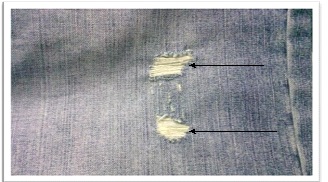 |
| Fig 05: Destroying sample By Machine |
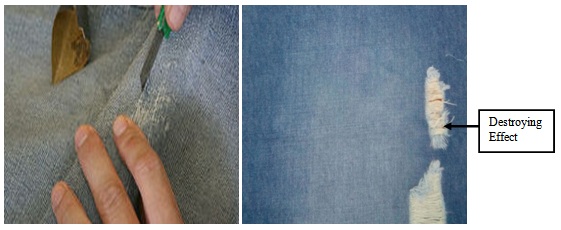 |
| Fig 06: Destroying sample By Knife |
Material: Plastic or Nylon Tag Pins
Instrument: Tagging Machine
Method:
Tacking or more commonly tag pinning is a very in fashion style in denim garment in these days. In this process the effect is created by swift tag machines with the help of plastic or nylon tag pins in rigid form of garment to get contrast.
Usually tag pin machines are used to attach tag pins to garment. The procedure is very simple and proceeds as; garment is folded on required area and tacked through folds. Number of folds can be two to four or five in regular in tacking. These tag guns are not especially designed for heavy folds like we do in tacking so durability of the gun is a consistent problem. Also broken needles of tag gun are issue for both operator and consumer. Automated tacking machines are used more successfully in some units. These machines are bit expensive but are far more efficient and secure than tag guns.
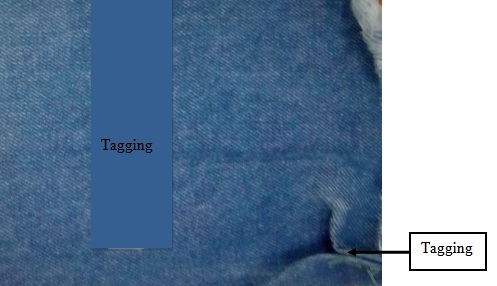 |
| Fig 07: Tagging Sample |
Material: Sand Paper
Instrument: Cutter Knife, Pattern Board, Rubber balloon etc
Method:
Various methods are designed to create this impression on jeans. Such as:-
Mostly rubber balloons are available with different pattern designs. Garments are mounted on balloons and filled with air to get impressions of whiskers. Garment is scrubbed over pattern carefully with sand paper on engraved pattern lines. This operation requires high skilled labor and who can handle uniformity and sequence in whisker line. Fabric may damage during rubbing if care is not taken. This method is famous for high quality and cost effectiveness.
Sometimes separate patterns are made and fixed on balloons to make mustaches. These patterns are made of thin rubber sheets and electric wires or rubber cords and pasted on balloons for pattern lines. Thin line patterns are very easy to work in that way but it is not much successful for broad lines.
Engraved patterns on thick board like hard rubber sheets are widely used for whiskers impression making. This idea is very simple to draw lines on rubber sheets and engrave them with blade. Garment is places on sheet and scrapped on specific area to draw this impression on garment. For its low cost patterns, it is most frequently used in small industries especially where the production is not consistent to style.
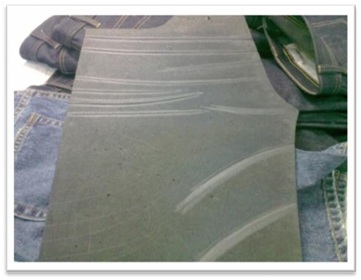 |
| Fig 08: Whiskering pattern made followed by a Style |
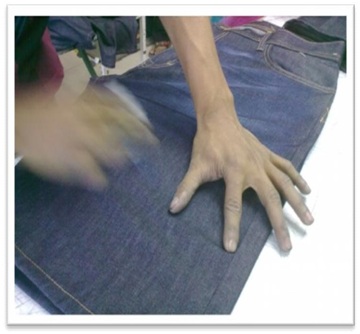 |
| Fig 09: Making whiskering effect on the body |
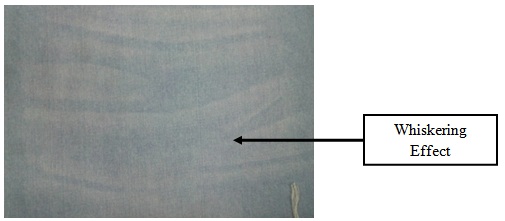 |
| Fig 10: Whiskering Sample |
Chemical: KMnO4
Material: Emery Paper
Instrument: P.P Spray Gun, Rubber Balloon etc
Method:
Potassium permanganate spray is done on jeans to take a bright effect on sand blast area. One important thing about the potassium permanganate (KMnO4) spray is, this is usually a sporting process to increase the effect of sand blast. Potassium permanganate solution is sprayed on the blasted area of jeans garment with the help of a normal spray gun & this solution is made by potassium permanganate & water, Sometimes CH3COOH (Acetic Acid) is used for solution preparation. Garments are mounted on balloons and filled with air to get impressions of PP spray. Garment is scrubbed over pattern carefully. This operation requires high skilled labor and who can handle uniformity.
This potassium permanganate spray appears pink on the garment when fresh and turns to muddy brown on drying. The garment is hanged in open to dry after potassium permanganate spray and when the potassium permanganate turns its colors completely then it is considered to ready for the next process. Doing after enzyme or bleach cycle will give more natural & white effect that doing in rigid.
It is always followed by neutralization process. Sodium Meta bi-sulphate is most commonly used neutralizer. A number of products are available in the market for the neutralization process like sodium meta bi-sulphate selected on the bases of effect required on blasted area.
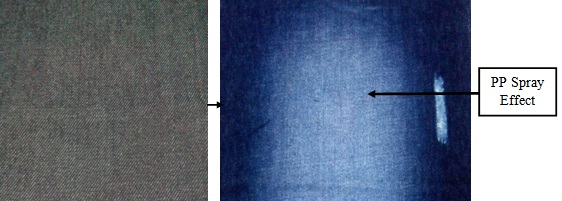 |
| Fig 11: Raw Sample Fig 12: PP Sample |
Next part will publish soon.....